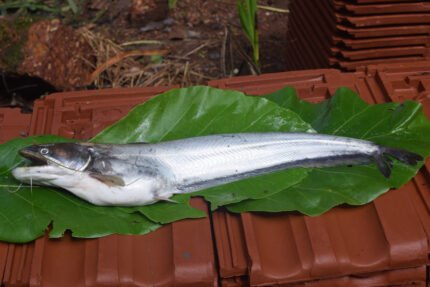Medically reviewed by Dr. Ramesh Gaddam, M.D. — Written by Sumalatha, D.N.H.E
Wallago Attu Catfih is a genus of catfish that includes several species commonly known as Wallago catfish. These freshwater catfish are found in various parts of Asia, particularly in rivers and lakes. One well-known species is Wallago attu, also known as the helicopter catfish or giant devil catfish.
Characteristics of Wallago attu
Wallago attu, commonly known as the helicopter catfish or giant devil catfish, exhibits several distinctive characteristics:
Size:
Wallago attu is known for its large size. It can grow to considerable lengths, with individuals reaching several feet. Adult specimens can be formidable in size, contributing to their popularity among anglers seeking a challenging catch.
Body Shape:
The body of Wallago attu is elongated and streamlined, typical of many catfish species. They have a powerful and muscular body, allowing them to be effective predators.
Head and Mouth:
The catfish has a large head and a wide mouth equipped with sharp teeth. These features are adaptations for capturing and consuming other fish, which make up the majority of their diet.
Coloration:
The coloration of Wallago attu can vary, but it often includes shades of brown or gray, helping them blend into their natural aquatic environments.
Behavior:
Wallago attu is a nocturnal predator, meaning it is more active during the night. They often hide in submerged structures or along the riverbed during the day and become more active in hunting during the cover of darkness.
Habitat:
This catfish species is typically found in freshwater habitats, including rivers, lakes, and reservoirs, across parts of Asia. They prefer slow-moving or still waters with sufficient hiding spots.
Reproductive Behavior:
Wallago attu engages in typical catfish reproductive behavior. The female lays eggs, and the male guards the nest until the eggs hatch. The young Wallago attu undergo a larval stage before developing into juvenile and eventually adult forms.
Predatory Behavior:
As a carnivorous species, Wallago attu preys on other fish. It is an opportunistic feeder, capable of ambushing its prey with quick and powerful movements.
Commercial and Recreational Importance:
Wallago attu is significant both commercially and recreationally. It is caught for food in some regions, and its large size and challenging nature make it a sought-after species for sport fishing.
It’s important to note that the characteristics of Wallago attu can vary somewhat based on factors such as regional differences, specific habitat conditions, and individual variations within the species.
Nutrition of Wallago Attu Catfish

Nutritional profile for catfish per 100 grams of cooked, dry heat:
| Nutrient | Amount per 100g |
|---|---|
| Calories | 105 |
| Protein | 20.3g |
| Total Fat | 2.2g |
| Saturated Fat | 0.6g |
| Omega-3 Fatty Acids (DHA+EPA) | 134mg |
| Omega-6 Fatty Acids | 151mg |
| Vitamin D | 4.8mcg |
| Vitamin B12 | 1.1mcg |
| Niacin (B3) | 2.3mg |
| Phosphorus | 204mg |
| Selenium | 23.7mcg |
Wallago Attu Catfish Benefits

General Information about the potential health benefits of consuming freshwater fish, which may also apply to Wallago catfish:
- Rich in Omega-3 Fatty Acids
- Protein Source
- Vitamins and Minerals
- Low in Saturated Fat
- Brain Health
Rich in Omega-3 Fatty Acids:
Like many other freshwater fish, Wallago catfish may contain omega-3 fatty acids, particularly eicosapentaenoic acid (EPA) and docosahexaenoic acid (DHA). These fatty acids are known for their cardiovascular benefits, including reducing the risk of heart disease.
Protein Source:
Fish, in general, is an excellent source of high-quality protein. Protein is essential for the body’s growth, maintenance, and repair of tissues.
Vitamins and Minerals:
Fish, including catfish, often contain essential vitamins and minerals such as vitamin D, vitamin B12, niacin, phosphorus, and selenium. These nutrients play crucial roles in bone health, energy metabolism, and overall well-being.
Low in Saturated Fat:
Fish is typically low in saturated fat compared to some other animal proteins. Consuming fish as part of a balanced diet may contribute to maintaining healthy cholesterol levels.
Brain Health:
The omega-3 fatty acids found in fish are associated with cognitive function and may contribute to brain health. DHA, in particular, is a key component of brain tissue.
It’s important to note that while fish can be a nutritious part of a diet, factors such as fishing practices, environmental pollution, and regional differences can impact the overall quality and safety of fish.
Always ensure that fish is sourced from reputable and sustainable sources, and consider consulting with a healthcare professional or a nutritionist for personalized dietary advice.
Wallago Attu Catfish Uses
Medically reviewed by Dr. Ramesh Gaddam, M.D.

General Physician, Diabetologist, and Critical Care Specialist.
Discover more from Health Build-Up
Subscribe to get the latest posts sent to your email.
